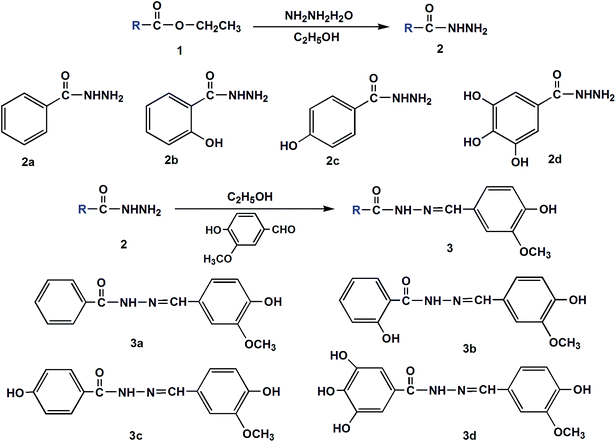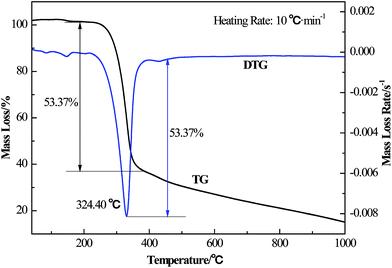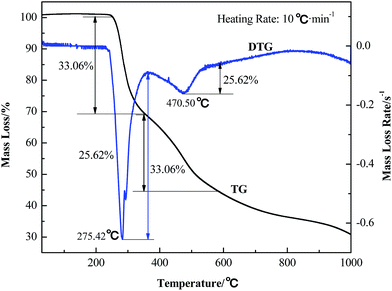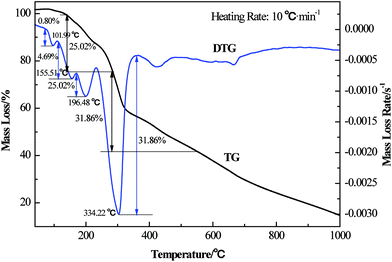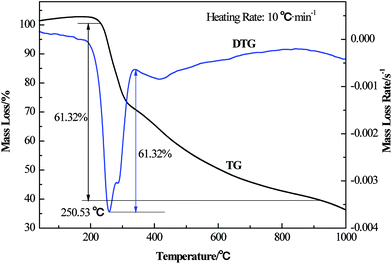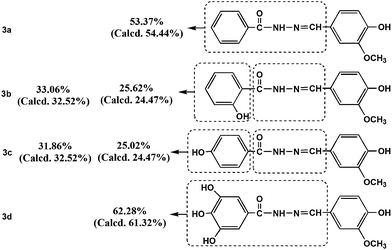4-Hydroxy-3-methoxy-benzaldehyde series aroyl hydrazones: synthesis, thermostability and antimicrobial activities
Liang Wanga,
Da-Gang Guo*a,
Yan-Yan Wangb and
Chang-Zheng Zheng*b
aState Key Laboratory for Mechanical Behavior of Materials, School of Materials Science and Engineering, Xi'an Jiaotong University, Xi'an 710049, China. E-mail: guodagang@mail.xjtu.edu.cn
bSchool of Environmental and Chemical Engineering, Xi'an Polytechnic University, Xi'an 710048, China. E-mail: wanglcody@163.com
First published on 17th October 2014
Abstract
Efficient synthetic procedures for the preparation of aroyl hydrazones were developed by converting the corresponding ethyl ester into hydrazides, followed by a reaction with 4-hydroxy-3-methoxy-benzaldehyde. A series of aromatic hydrazides and aroyl hydrazones were characterized by elemental analysis, IR, 1H NMR, 13C NMR and thermogravimetric analysis. The thermal gravity analysis showed that the compounds 3a–3d were stable below 228.23, 227.65, 118.97 and 179.51 °C, respectively. The aromatic hydrazides and aroyl hydrazones showed antimicrobial activity towards Staplylococcus aureus, Escherichia coli and Pseudomonas aeruginosa. The antibacterial activity experiments indicated that aroyl hydrazones had higher activity than the hydrazides. The presence of a hydroxyl group, as well as the number and position of the hydroxyl groups, were important and further enhance the antimicrobial activity.
1. Introduction
During the past two decades, the frequency and types of life-threatening infections has increased. A major associated problem is that the incidence of drug-resistant isolated bacterial strains in the community has become quite alarming. For these reasons, the demand for new and better chemotherapic compounds has increased, and nowadays the search for new chemicals with antimicrobial activity has become an important field of research.1–4Hydrazides are highly reactive base with reducing properties. They have been used as a synthetic intermediate to produce several different types of drugs and in the treatment of various chronic illnesses.5 Hydrazides used in medicine include the anti-tuberculosis drug isoniazid and the antihypertensive and peripheral vasodilator drug hydralsane, whose hydrochloride is an effective drug for emergency reduction of blood pressure in hypertensive crisis.6–8 Similarly, the hydralazine derivatives have been widely applied in the treatment of tuberculosis and mental disorder. Also, they can be used as antimicrobial, antihypertensive, antimalarial and antitumoral agents.9–13
Hydrazones containing an azometine –NHN![[double bond, length as m-dash]](https://www.rsc.org/images/entities/char_e001.gif) CH– proton are synthesized by heating the appropriate substituted hydrazides with aldehydes and ketones in solvents like ethanol, methanol, tetrahydrofuran. Hydrazides and hydrazones are not only intermediates but they are also very effective organic compounds in their own right.
CH– proton are synthesized by heating the appropriate substituted hydrazides with aldehydes and ketones in solvents like ethanol, methanol, tetrahydrofuran. Hydrazides and hydrazones are not only intermediates but they are also very effective organic compounds in their own right.
Aroylhydrazones (>C![[double bond, length as m-dash]](https://www.rsc.org/images/entities/char_e001.gif) N–NH–CO–) are special group of compounds due to their wide applications in chemistry and biology and characterized by the presence two inter-linked nitrogen atoms as Nsp2–Nsp3. Aroylhydrazones have been attracting much attention from chemists in recent years because of their biological activities, chemical and industrial versatility, and strong tendency to chelate to transition metals.14–16 However, the most valuable property of aroylhydrazones is their great physiological activity due to the presence of the active pharmacophore and provides application in medicinal and pharmaceutical fields with various biological applications.17 Since it is well known that the hydrazone group plays an important role for the antimicrobial activity. Aroylhydrazones are being synthesized in order to combat diseases with minimal toxicity and maximal efficiency. These predictions has provided therapeutic pathway to develop new effective biologically active hydrazones. A number of hydrazone derivatives have been reported to exhibit notably antimicrobial, anticonvulsant, antiinflammatory, antitubercular and antitumoral activities.18–22 Careful literature survey for functional groups which could be considered as pharmacophores for the antitubercular activities revealed that the hydrazone moiety is common among most of the antitubercular agents such as salinazid and verazide.23,24 Therefore, the target compounds were rationalized so as to comprise the hydrazone pharmacophores that are believed to be responsible for the biological significance of some relevant chemotherapeutic agents. The substitution pattern of such hydrazone derivatives was carefully selected so as to confer different electronic environment to the molecules. Such hydrazide–hydrazones compounds were designed in order to investigate the effect of such structural variation on the antibacterial activities.
N–NH–CO–) are special group of compounds due to their wide applications in chemistry and biology and characterized by the presence two inter-linked nitrogen atoms as Nsp2–Nsp3. Aroylhydrazones have been attracting much attention from chemists in recent years because of their biological activities, chemical and industrial versatility, and strong tendency to chelate to transition metals.14–16 However, the most valuable property of aroylhydrazones is their great physiological activity due to the presence of the active pharmacophore and provides application in medicinal and pharmaceutical fields with various biological applications.17 Since it is well known that the hydrazone group plays an important role for the antimicrobial activity. Aroylhydrazones are being synthesized in order to combat diseases with minimal toxicity and maximal efficiency. These predictions has provided therapeutic pathway to develop new effective biologically active hydrazones. A number of hydrazone derivatives have been reported to exhibit notably antimicrobial, anticonvulsant, antiinflammatory, antitubercular and antitumoral activities.18–22 Careful literature survey for functional groups which could be considered as pharmacophores for the antitubercular activities revealed that the hydrazone moiety is common among most of the antitubercular agents such as salinazid and verazide.23,24 Therefore, the target compounds were rationalized so as to comprise the hydrazone pharmacophores that are believed to be responsible for the biological significance of some relevant chemotherapeutic agents. The substitution pattern of such hydrazone derivatives was carefully selected so as to confer different electronic environment to the molecules. Such hydrazide–hydrazones compounds were designed in order to investigate the effect of such structural variation on the antibacterial activities.
In view of these observations, herein we report the synthesis, characterization and antimicrobial activity of series of aromatic hydrazides and aroyl hydrazones with different position and number of the hydroxyl groups in their molecules as trial to develop a novel antimicrobial. The antibacterial activity of the compounds to Staplylococcus aureus, Escherichia coli and Pseudomonas aeruginosa were measured. Their structure and activity relationship were also examined. In addition, aroyl hydrazones thermal behaviors are studied by TG–DTG. The thermal analysis exhibit either mass loss or gain due to decomposition, oxidation, or loss of volatiles.
2. Results and discussion
2.1. Chemistry
The aromatic hydrazides were obtained from the condensation of aromatic ethyl ester with hydrazine hydrate. And the aroyl hydrazones were obtained from the condensation of hydrazide with 4-hydroxy-3-methoxybenzaldehyde (Scheme 1). The investigation showed that the aroyl hydrazones were obtained in molar ratio 1![[thin space (1/6-em)]](https://www.rsc.org/images/entities/char_2009.gif) :
:![[thin space (1/6-em)]](https://www.rsc.org/images/entities/char_2009.gif) 1 hydrazide–aldehyde ratio. At room temperature, aromatic hydrazides and aroyl hydrazones were very stable. These compounds were characterised by elemental analysis and other spectroscopic techniques. The compounds are soluble in methanol, ethanol, DMF and acetonitrile. Initially, the two-step reaction was carried out with different solvent under reflux. In our observations, ethanol was sufficient for the synthesis of the compounds (2a–2d, 3a–3d) with high yield.
1 hydrazide–aldehyde ratio. At room temperature, aromatic hydrazides and aroyl hydrazones were very stable. These compounds were characterised by elemental analysis and other spectroscopic techniques. The compounds are soluble in methanol, ethanol, DMF and acetonitrile. Initially, the two-step reaction was carried out with different solvent under reflux. In our observations, ethanol was sufficient for the synthesis of the compounds (2a–2d, 3a–3d) with high yield.
Wave numbers of the selected vibration of IR spectra of the compounds are listed in Experimental section. The IR spectrum of the compounds (3a–3d) are compared with the compounds (2a–2d) to determine the binding mode of the aromatic hydrazides to aroyl hydrazones during the condensation. The IR spectra of the compounds were found to be very similar to each other. The IR spectra of the aromatic hydrazides displaying a sharp band around 1400 cm−1 were assigned to C–N stretching. However, in the aroyl hydrazones, this band was changed to higher (4–18 cm−1) wavenumbers indicating the participation of nitrogen and carbon formed a double bond (imine nitrogen). As a general remark, a broad band in the range of 3395 cm−1 free v(OH) stretching frequencies was observed in the spectra of aromatic hydrazides (2b–2d). In the same way, in the spectrum of the corresponding aroyl hydrazones, this band was in the range of 3481 cm−1 free v(OH) stretching frequencies. Terminal methyl stretching vibrations were found in the range of 2996–2838 cm−1. The spectra of all the compounds showed shifts for m(C![[double bond, length as m-dash]](https://www.rsc.org/images/entities/char_e001.gif) O) at 1602–1684 cm−1. Moreover, new band in the aroyl hydrazones at 1201–1284 cm−1 was attributed to the m(C–O) vibrations.
O) at 1602–1684 cm−1. Moreover, new band in the aroyl hydrazones at 1201–1284 cm−1 was attributed to the m(C–O) vibrations.
NMR spectra of compounds were recorded in DMSO (CD3OD) taking using TMS as an internal standard. 1H NMR and 13C NMR spectra for the compounds are given in Experimental, respectively. It is known that symmetric C and H atoms in the compounds have the same chemical shift because of the same chemical environment of the atoms. Chemical shift values of compounds (2a–2d, 3a–3d) is in reasonable agreement with literature data for the similar compounds.25,26 In NMR spectra, aromatic proton peaks were observed at about 6.78–7.96 ppm, and aromatic carbon peaks were shown at 108.54–160.72 ppm. The chemical shift of the NH group of the compounds in DMSO-d6 is in the range of 8.25–9.77 ppm. Difference of chemical shift might be attributed to the formation of intermolecular interactions with polar solvent DMSO. The 13C NMR of aromatic hydrazide and aroyl hydrazone, confirmed the appearance of carbonyl in the high field region. The other carbon atoms of the phenyl moieties all appeared at the expected chemical shifts.
2.2. Thermogravimetric analysis
Thermogravimetric analysis was carried out to examine the thermal stability of 3a–3d. The crushed single crystal sample was heated up to 1000 °C in N2 at a heating rate of 10 °C min−1. The stages of decomposition, temperature range as well as the weight loss percentages of aroyl hydrazones are shown in Fig. 1–4. The experimental weight loss values are in good agreement with the calculated values.The TG curves for 3a showed that it is stable up to 228.23 °C without any weight loss, which means the compound could retain structural integrity to 228.23 °C. It can be seen from Fig. 1, 3a undergoes one major stage of weight loss during 228.23–369.26 °C, and the endothermic peak is in the temperature of 324.40 °C at the heating rate of 10 °C min−1. The value of the weight loss at this stage is 53.37% (calcd 54.44%), and the lost group is shown in Fig. 5. In Fig. 2, two stages of weight loss of 3b can be clearly discerned under the heating rate of 10 °C min−1. The first step starts from 227.65 °C and ends at 345.54 °C with the sum loss of 33.06% (calcd 32.52%). The second stage occurred at 394.08–526.38 °C with the mass loss of 25.62% (calcd 24.47%), which is shown in Fig. 5. The endothermic peak are in the temperature of 275.42 °C and 470.50 °C, respectively. In the TG and DTG curves of 3c, as described in Fig. 3, four mass loss stages are observed. The first two step starts from 86.17 °C and ends at 165.63 °C with the sum loss of 0.80% and 4.69% which should be assigned to the water in the sample. The third step starts from 169.29 °C and ends at 224.78 °C with the sum loss of 25.02% (calcd 24.47%), and the endothermic peak is in the temperature of 196.48 °C. The fourth step starts from 227.64 °C and remains level at 334.22 °C. In this temperature region, the sum of weight loss is 31.86% (calcd 32.52%) and the decomposition process is represented in Fig. 5. The TG curves for 3d showed that it is stable up to 179.51 °C without any weight loss, which means the compound could retain structural integrity to 179.51 °C (Fig. 4). The one major stage starts from 179.51 °C and ends at 318.03 °C with the sum loss of 62.28% (calcd 61.32%) and the endothermic peak is in the temperature of 250.53 °C at the heating rate of 10 °C min−1. The decomposition process is represented in Fig. 5. The final residue was probably 4-hydroxy-3-methoxy-phenyl fragments.
2.3. Antibacterial activity
The antibacterial activities of the tested compounds were examined with Staplylococcus aureus, Escherichia coli and Pseudomonas aeruginosa. The antibacterial screening of the compound was evaluated at the concentration of 5 × 105–5 × 106 cfu mL−1, and the inhibition zones were measured in mm. The activity of the aromatic hydrazides and aroyl hydrazones against the used organisms are depicted in Table 1. As shown in Table 1, the synthesized compounds showed different antibacterial activities. The mean values of three independent measurements for each compound were shown in Fig. 6. On the basis of the data obtained for diameter of inhibition zone, it was found that all of the compounds were active on three types of bacterial strains. 2a have poor activity against microorganism. The compounds (2b–2d, 3a–3d) exhibited a remarkable antibacterial activity against all organisms. Aroyl hydrazones(3a–3d) inhibitory activity are stronger than aromatic hydrazides(2a–2d). The series of hydrazides antibacterial activity from strong to weak order: 2d, 2c, 2b, 2a. The series of aroyl hydrazones antibacterial activity from strong to weak order: 3d, 3c, 3b, 3a. The correlations between functional groups and antibacterial activities show that 3d has the highest activity against microorganisms. Reason of this phenomena can be explained due to presence delocalization of π electrons over the whole aromatic ring and also its activity may be arise from the hydroxyl group which may play an important role in the antimicrobial activity. The electronic delocalization supposed within the aromatic ring system may increase the lipophilic character of the compounds. Test results show that the presence of hydroxyl group, as well as the number and position of hydroxyl groups, are important and further enhance the antimicrobial activity. The more hydroxyl group, the higher of the antimicrobial activity. Comparing with 2b (3b), 2c (3c) have less space steric hindrance. Counterpoint to introduce hydroxyl compounds in less space steric hindrance, so that the antibacterial activity was improved.| Organism | S. aureus (ATCC 25923) | E. coli (ATCC 25922) | P. aeruginosa (ATCC 27853) | ||||||
|---|---|---|---|---|---|---|---|---|---|
| sample | 1 | 2 | 3 | 1 | 2 | 3 | 1 | 2 | 3 |
| a Note: more than 7 mm in diameter with antibacterial activities. | |||||||||
| N,N-Dimethylformamide | 6.00 | 6.00 | 6.00 | 6.00 | 6.00 | 6.00 | 6.00 | 6.00 | 6.00 |
| 2a | 7.32 | 7.36 | 7.43 | 7.26 | 7.28 | 7.44 | 7.06 | 7.12 | 7.13 |
| 2b | 8.05 | 8.13 | 8.18 | 8.30 | 8.42 | 8.41 | 8.34 | 8.26 | 8.21 |
| 2c | 8.27 | 8.35 | 8.34 | 8.58 | 8.61 | 8.63 | 8.67 | 8.74 | 8.81 |
| 2d | 10.58 | 11.06 | 11.06 | 11.34 | 11.34 | 11.45 | 11.14 | 11.15 | 11.22 |
| 3a | 9.22 | 9.25 | 9.36 | 9.05 | 9.16 | 9.11 | 9.18 | 9.22 | 9.24 |
| 3b | 10.55 | 10.62 | 10.52 | 10.24 | 10.37 | 10.37 | 10.39 | 10.48 | 10.46 |
| 3c | 10.77 | 10.74 | 10.60 | 10.71 | 10.83 | 10.82 | 10.58 | 10.65 | 10.68 |
| 3d | 12.22 | 12.15 | 12.05 | 12.44 | 12.42 | 12.29 | 12.31 | 12.45 | 12.41 |
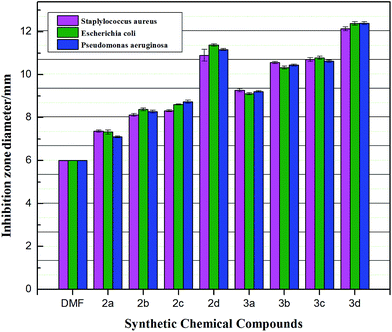 | ||
| Fig. 6 Antimicrobial activities of compounds against bacteria. Values are average of three independent measurements for each compound. | ||
3. Experimental section
3.1. Materials and physical measurements
All starting materials and solvents used in this work were of analytical grade and used as purchased from Sinopharm Chemical Reagent Co. Ltd without further purification. Melting points were determined in open capillaries on a Mel-Temp apparatus and are uncorrected. Elemental analyses (C, H, N) were performed using a Vario EL elemental analyzer. FT-IR spectrum was measured as KBr pellets on a Nicolet Nexus FT-IR spectrometer in the 4000–400 cm−1 region. The 1H NMR and 13C NMR spectra were recorded in DMSO-d6 on a Bruker-400 spectrometer (400 MHz). All the chemical shifts are reported in δ (ppm) using TMS as an internal standard. Thermogravimetric analyses (TGA) were carried out on a Perkin-Elmer Pyris-1, thermogravimetric analyzer operating at a heating rate of 10 °C min−1 in a flow of dry oxygen-free nitrogen at 20 mL min−1.3.2. Synthesis
![[double bond, length as m-dash]](https://www.rsc.org/images/entities/char_e001.gif) O) 1659; ν(C–N) 1402. 1H NMR (400 MHz, DMSO-d6): δ 9.77 (s, 1H, NH), 7.83–7.81 (m, 2H, o-PhH), 7.53–7.43 (m, 3H, PhH), 3.35 (s, 2H, NH2). 13C NMR (400 MHz, DMSO-d6): 167.22 (C
O) 1659; ν(C–N) 1402. 1H NMR (400 MHz, DMSO-d6): δ 9.77 (s, 1H, NH), 7.83–7.81 (m, 2H, o-PhH), 7.53–7.43 (m, 3H, PhH), 3.35 (s, 2H, NH2). 13C NMR (400 MHz, DMSO-d6): 167.22 (C![[double bond, length as m-dash]](https://www.rsc.org/images/entities/char_e001.gif) O), 133.15 (ArC), 131.94 (ArC), 128.26 (ArC), 127.36 (ArC).
O), 133.15 (ArC), 131.94 (ArC), 128.26 (ArC), 127.36 (ArC).![[double bond, length as m-dash]](https://www.rsc.org/images/entities/char_e001.gif) O) 1643; ν(C–N) 1420; ν(C–O) 1284. 1H NMR (400 MHz, CD3OD): δ 8.25 (s, 1H, NH), 7.96–7.94 (m, 2H, o-PhH), 7.64–7.46 (m, 3H, m-PhH, p-PhH), 7.11 (dd, J = 2, 8.4 Hz, 2H, o-ArH), 6.85 (d, J = 8 Hz, 1H, m-ArH), 4.91 (s, 1H, ArOH), 3.97 (s, 3H, CH3), 3.33 (s, 1H, CH
O) 1643; ν(C–N) 1420; ν(C–O) 1284. 1H NMR (400 MHz, CD3OD): δ 8.25 (s, 1H, NH), 7.96–7.94 (m, 2H, o-PhH), 7.64–7.46 (m, 3H, m-PhH, p-PhH), 7.11 (dd, J = 2, 8.4 Hz, 2H, o-ArH), 6.85 (d, J = 8 Hz, 1H, m-ArH), 4.91 (s, 1H, ArOH), 3.97 (s, 3H, CH3), 3.33 (s, 1H, CH![[double bond, length as m-dash]](https://www.rsc.org/images/entities/char_e001.gif) N). 13C NMR (400 MHz, d4-methanol): 170.15 (C
N). 13C NMR (400 MHz, d4-methanol): 170.15 (C![[double bond, length as m-dash]](https://www.rsc.org/images/entities/char_e001.gif) O), 154.75 (C
O), 154.75 (C![[double bond, length as m-dash]](https://www.rsc.org/images/entities/char_e001.gif) N), 149.30, 145.22, 133.54, 131.89, 128.62, 127.37, 124.28, 122.76, 116.81, 116.05 (aromatic carbons), 56.32 (OCH3).
N), 149.30, 145.22, 133.54, 131.89, 128.62, 127.37, 124.28, 122.76, 116.81, 116.05 (aromatic carbons), 56.32 (OCH3).![[double bond, length as m-dash]](https://www.rsc.org/images/entities/char_e001.gif) O) 1648; ν(C–N) 1417. 1H NMR (400 MHz, DMSO-d6): δ 7.81 (dd, J = 1.6, 8.0 Hz, 1H, NH), 7.38 (td, J = 8.4, 1.6 Hz, 1H, p-ArH), 6.91–6.84 (m, 3H, ArH), 4.65 (s, 1H, Ph-OH), 3.35 (s, 2H, NH2). 13C NMR (400 MHz, DMSO-d6): 165.34 (C
O) 1648; ν(C–N) 1417. 1H NMR (400 MHz, DMSO-d6): δ 7.81 (dd, J = 1.6, 8.0 Hz, 1H, NH), 7.38 (td, J = 8.4, 1.6 Hz, 1H, p-ArH), 6.91–6.84 (m, 3H, ArH), 4.65 (s, 1H, Ph-OH), 3.35 (s, 2H, NH2). 13C NMR (400 MHz, DMSO-d6): 165.34 (C![[double bond, length as m-dash]](https://www.rsc.org/images/entities/char_e001.gif) O), 156.14 (ArC), 133.33 (ArC), 128.67 (ArC), 121.29 (ArC), 120.77 (ArC), 115.28 (ArC).
O), 156.14 (ArC), 133.33 (ArC), 128.67 (ArC), 121.29 (ArC), 120.77 (ArC), 115.28 (ArC).![[double bond, length as m-dash]](https://www.rsc.org/images/entities/char_e001.gif) O) 1635; ν(C–N) 1422; ν(C–O) 1276. 1H NMR (400 MHz, DMSO-d6): δ 8.35 (s, 1H, NH), 7.89 (dd, J = 1.2, 7.6 Hz, 1H, o-ArH), 7.46–7.42 (m, 2H, ArOH), 7.33 (d, J = 1.6 Hz, 1H, p-PhH), 7.12 (dd, J = 1.6, 8 Hz, 2H, o-ArH), 6.96 (t, J = 8.8 Hz, 1H, m-PhH), 6.86 (d, J = 8.4 Hz, 1H, m-ArH), 3.84 (s, 3H, CH3), 3.34 (s, 1H, CH
O) 1635; ν(C–N) 1422; ν(C–O) 1276. 1H NMR (400 MHz, DMSO-d6): δ 8.35 (s, 1H, NH), 7.89 (dd, J = 1.2, 7.6 Hz, 1H, o-ArH), 7.46–7.42 (m, 2H, ArOH), 7.33 (d, J = 1.6 Hz, 1H, p-PhH), 7.12 (dd, J = 1.6, 8 Hz, 2H, o-ArH), 6.96 (t, J = 8.8 Hz, 1H, m-PhH), 6.86 (d, J = 8.4 Hz, 1H, m-ArH), 3.84 (s, 3H, CH3), 3.34 (s, 1H, CH![[double bond, length as m-dash]](https://www.rsc.org/images/entities/char_e001.gif) N). 13C NMR (400 MHz, DMSO-d6): 171.36 (C
N). 13C NMR (400 MHz, DMSO-d6): 171.36 (C![[double bond, length as m-dash]](https://www.rsc.org/images/entities/char_e001.gif) O), 153.68 (C
O), 153.68 (C![[double bond, length as m-dash]](https://www.rsc.org/images/entities/char_e001.gif) N), 156.19, 149.31, 145.12, 133.33, 128.07, 124.85, 122.72, 121.21, 120.67, 116.88, 116.04, 115.83 (aromatic carbons), 56.38 (OCH3).
N), 156.19, 149.31, 145.12, 133.33, 128.07, 124.85, 122.72, 121.21, 120.67, 116.88, 116.04, 115.83 (aromatic carbons), 56.38 (OCH3).![[double bond, length as m-dash]](https://www.rsc.org/images/entities/char_e001.gif) O) 1684; ν(C–N) 1411. 1H NMR (400 MHz, DMSO-d6): δ 9.49 (s, 1H, NH), 7.82–7.68 (m, 2H, o-ArH), 6.85 (d, J = 8.4 Hz, 1H, m-ArH), 6.78 (d, J = 8.8 Hz, 1H, m-ArH), 4.39 (s, 1H, Ph-OH), 3.78 (s, 2H, NH2). 13C NMR (400 MHz, DMSO-d6): 167.26 (C
O) 1684; ν(C–N) 1411. 1H NMR (400 MHz, DMSO-d6): δ 9.49 (s, 1H, NH), 7.82–7.68 (m, 2H, o-ArH), 6.85 (d, J = 8.4 Hz, 1H, m-ArH), 6.78 (d, J = 8.8 Hz, 1H, m-ArH), 4.39 (s, 1H, Ph-OH), 3.78 (s, 2H, NH2). 13C NMR (400 MHz, DMSO-d6): 167.26 (C![[double bond, length as m-dash]](https://www.rsc.org/images/entities/char_e001.gif) O), 160.72 (ArC), 128.25 (ArC), 126.13 (ArC), 115.87 (ArC).
O), 160.72 (ArC), 128.25 (ArC), 126.13 (ArC), 115.87 (ArC).![[double bond, length as m-dash]](https://www.rsc.org/images/entities/char_e001.gif) O) 1623; ν(C–N) 1425; ν(C–O) 1241. 1H NMR (400 MHz, DMSO-d6): δ 8.58 (s, 1H, NH), 7.80–7.39 (m, 4H, o-ArH), 7.25 (dd, J = 2, 8.4 Hz, 2H, ArOH), 6.97 (d, J = 8 Hz, 2H, m-ArH), 6.88 (d, J = 8 Hz, 1H, m-ArH), 3.84 (s, 3H, CH3), 3.36 (s, 1H, CH
O) 1623; ν(C–N) 1425; ν(C–O) 1241. 1H NMR (400 MHz, DMSO-d6): δ 8.58 (s, 1H, NH), 7.80–7.39 (m, 4H, o-ArH), 7.25 (dd, J = 2, 8.4 Hz, 2H, ArOH), 6.97 (d, J = 8 Hz, 2H, m-ArH), 6.88 (d, J = 8 Hz, 1H, m-ArH), 3.84 (s, 3H, CH3), 3.36 (s, 1H, CH![[double bond, length as m-dash]](https://www.rsc.org/images/entities/char_e001.gif) N). 13C NMR (400 MHz, DMSO-d6): 168.42 (C
N). 13C NMR (400 MHz, DMSO-d6): 168.42 (C![[double bond, length as m-dash]](https://www.rsc.org/images/entities/char_e001.gif) O), 154.59 (C
O), 154.59 (C![[double bond, length as m-dash]](https://www.rsc.org/images/entities/char_e001.gif) N), 160.07, 149.33, 145.28, 128.74, 126.16, 124.68, 122.73, 116.82, 116.09, 115.86 (aromatic carbons), 56.29 (OCH3).
N), 160.07, 149.33, 145.28, 128.74, 126.16, 124.68, 122.73, 116.82, 116.09, 115.86 (aromatic carbons), 56.29 (OCH3).![[double bond, length as m-dash]](https://www.rsc.org/images/entities/char_e001.gif) O) 1657; ν(C–N) 1418. 1H NMR (400 MHz, DMSO-d6): δ 8.32 (s, 1H, NH), 6.92, 6.78 (s, 2H, o-ArH), 4.20 (s, 3H, Ar-OH), 3.73 (s, 2H, NH2). 13C NMR (400 MHz, DMSO-d6): 168.37 (C
O) 1657; ν(C–N) 1418. 1H NMR (400 MHz, DMSO-d6): δ 8.32 (s, 1H, NH), 6.92, 6.78 (s, 2H, o-ArH), 4.20 (s, 3H, Ar-OH), 3.73 (s, 2H, NH2). 13C NMR (400 MHz, DMSO-d6): 168.37 (C![[double bond, length as m-dash]](https://www.rsc.org/images/entities/char_e001.gif) O), 146.10 (ArC), 135.16 (ArC), 128.09 (ArC), 108.54 (ArC).
O), 146.10 (ArC), 135.16 (ArC), 128.09 (ArC), 108.54 (ArC).![[double bond, length as m-dash]](https://www.rsc.org/images/entities/char_e001.gif) O) 1602; ν(C–N) 1422; ν(C–O) 1201. 1H NMR (400 MHz, DMSO-d6): δ 8.58 (s, 1H, NH), 7.46 (d, J = 1.6 Hz, 1H, o-ArH), 7.25 (dd, J = 1.6, 8.4 Hz, 4H, ArOH), 6.94 (s, 1H, o-ArH), 6.88 (d, J = 8 Hz, 1H, m-ArH), 6.79 (s, 2H, o-ArH), 3.84 (s, 3H, CH3), 3.36 (s, 1H, CH
O) 1602; ν(C–N) 1422; ν(C–O) 1201. 1H NMR (400 MHz, DMSO-d6): δ 8.58 (s, 1H, NH), 7.46 (d, J = 1.6 Hz, 1H, o-ArH), 7.25 (dd, J = 1.6, 8.4 Hz, 4H, ArOH), 6.94 (s, 1H, o-ArH), 6.88 (d, J = 8 Hz, 1H, m-ArH), 6.79 (s, 2H, o-ArH), 3.84 (s, 3H, CH3), 3.36 (s, 1H, CH![[double bond, length as m-dash]](https://www.rsc.org/images/entities/char_e001.gif) N). 13C NMR (400 MHz, DMSO-d6): 170.27 (C
N). 13C NMR (400 MHz, DMSO-d6): 170.27 (C![[double bond, length as m-dash]](https://www.rsc.org/images/entities/char_e001.gif) O), 155.23 (C
O), 155.23 (C![[double bond, length as m-dash]](https://www.rsc.org/images/entities/char_e001.gif) N), 149.39, 146.09, 145.02, 135.12, 128.92, 124.83, 122.77, 116.82, 116.04, 108.55 (aromatic carbons), 56.21 (OCH3).
N), 149.39, 146.09, 145.02, 135.12, 128.92, 124.83, 122.77, 116.82, 116.04, 108.55 (aromatic carbons), 56.21 (OCH3).3.3. Temperature programmed combustion
The experiments were performed in a Perkin-Elmer Pyris-1 thermogravimetric analyzer with the sample mass loss percentage and mass loss rate (TG–DTG signal) as functions of time or temperature recorded continuously under the temperature programmed combustion. During the experiments, the temperature increased from 25 to 1000 °C at a linear heating rate of 10 °C min−1. At the same time, the chamber blowing gas, N2 (99.99% purity), was fixed at 20 mL min−1. When data derived from TG–DTG curves were analyzed, they would be dealt with taking the original sample mass into consideration to eliminate the effect of mass different on the process. The detailed TG–DTG curves and educed data are shown in corresponding section which validates the stability of the experimental system.3.4. Preparation of microbial cultures
Microorganisms were provided from the culture collection of the Biotechnology Laboratory of the affiliated hospital of Xi'an Medical University, China. Staplylococcus aureus ATCC 25923, Escherichia coli ATCC 25922 and Pseudomonas aeruginosa ATCC 27853 were used as the test organisms in this study. Bacterial strains were inoculated into Nutrient Broth (Difco) and incubated at 30 ± 0.1 °C for 24 h. In order to test the antimicrobial effects of aromatic compounds, 15 mL of Mueller-Hinton agar (Merck) for bacteria, and YPD Agar (Merck) were placed in Petri dishes which were then inoculated with strains of bacteria by taking 100 μL from cell culture media. Test compounds and 15 mL of YPD Agar (Merck) were placed in Petri dishes which were then inoculate temperature for a while, and then holes were made on top with a sterile stick. It was left to solidify at room entities stated above were then added to these holes. Petri dishes were left at 4 °C for 2 h. Then, bacterial cultures were incubated at 34 ± 0.1 °C for 24 h, and yeast cultures were incubated at 30 ± 0.1 °C for 72 h. And the end of incubation time, the inhibition zones on the bacterial and yeast nutrient media were measured as diameter zone, mm.27,28 All the tested compounds were solubilized in DMF as a solvent. The antimicrobial activity results are the average data of three experiments.4. Conclusions
A series of aromatic hydrazides and aroyl hydrazones had been successfully prepared from readily available starting compounds with convenient procedure and screened for their antimicrobial application. It was found that both number and position of hydroxyl groups contained in the compounds displayed remarkable difference in antimicrobial activity and particularly compared to the other compounds. The present initial study implies that the aromatic hydrazides and aroyl hydrazones would be potential medicinal antimicrobial material. Keeping in view the above importance of the compounds, we thought it worthwhile to construct the aromatic hydrazides and aroyl hydrazones and theirs coordination compounds with metal ions. Our efforts are ongoing in this field and will be reported subsequently in the future.Conflicts of interest
The author(s) confirms that this article content has no conflicts of interest.Acknowledgements
This work was supported financially by the Fundamental Research Funds for the Central University, the National Natural Science Foundation of China (no. 51072159; 51273159) and Program for New Century Excellent Talents in Universities (Chinese Ministry of Education, NCET-08-0444).References
- S. F. A. Bruggraber, G. French, R. P. H. Thompson and J. J. Powell, Helicobacter, 2004, 9, 422–428 CrossRef CAS PubMed.
- Z. H. Chohan, H. Pervez, A. Rauf, K. M. Khan and C. T. Supuran, J. Enzyme Inhib. Med. Chem., 2006, 21, 193–201 CrossRef CAS PubMed.
- S. D. Mills, Biochem. Pharmacol., 2006, 71, 1096–1102 CrossRef CAS PubMed.
- H. G. Aslan and N. Karacan, Med. Chem. Res., 2013, 22, 1330–1338 CrossRef CAS.
- R. Vonburg and T. Stout, J. Appl. Toxicol., 1991, 11, 447–450 CrossRef CAS.
- E. O. Chester, G. Norris and D. D. Raymond, Anal. Profiles Drug Subst., 1979, 8, 283–314 Search PubMed.
- K. K. Bedia, O. Elcin, U. Seda, K. Fatma, S. Nathaly, R. Sevim and A. Dimoglo, Eur. J. Med. Chem., 2006, 41, 1253–1261 CrossRef CAS PubMed.
- N. N. Emmanuel, H. Ahmad, M. M. Felicite, N. N. Innocent, E. O. Offiong and A. B. Susan, Polyhedron, 2013, 63, 207–213 CrossRef PubMed.
- A. Kajal, S. Bala, S. Kamboj and V. Saini, Med. Chem. Res., 2014, 23, 2676–2689 CrossRef CAS.
- P. Cikla, E. Tatar, I. Kucukguzel, F. Sahin, D. Yurdakul, A. Basu, R. Krishnan, D. B. Nichols, N. Kaushik-Basu and S. G. Kucukguzel, Med. Chem. Res., 2013, 22, 5685–5699 CrossRef CAS.
- L. T. Yildirim and O. Atakol, Cryst. Res. Technol., 2002, 37, 1352–1359 CrossRef CAS.
- L. T. Yildirim, K. C. Emregul, R. Kurtaran and O. Atakol, Cryst. Res. Technol., 2002, 37, 1344–1351 CrossRef CAS.
- K. K. Bedia, E. E. Oruc-Emre, S. Unsalan and S. Rollas, Med. Chem. Res., 2009, 18, 277–286 CrossRef.
- C. Sousa, C. Freire and B. Castro, Molecules, 2003, 8, 894–900 CrossRef CAS PubMed.
- P. V. Chalapathi, B. Prathima, S. Y. Rao, K. J. Reddy, G. N. Ramesh, D. V. R. Reddy and A. Varadareddy, Res. J. Chem. Environ., 2011, 15, 579–585 CAS.
- C. Z. Zheng, L. Wang and J. Liu, J. Mol. Struct., 2012, 1018, 78–83 CrossRef CAS PubMed.
- R. N. Singh, A. Kumar, P. Rawat and A. Srivastsva, J. Mol. Struct., 2013, 1049, 419–428 CrossRef CAS PubMed.
- H. M. Eisa, A. S. Tantawy and M. M. El-Kerdawy, Pharmazie, 1991, 46, 182–184 CAS.
- P. P. T. Sah and S. A. Peoples, J. Am. Pharm. Assoc., Sci. Ed., 1954, 43, 513–524 CrossRef CAS.
- S. S. Parmar, A. K. Gupta, T. K. Gupta and V. I. Stenberg, J. Pharm. Sci., 1975, 64, 154–157 CrossRef CAS.
- R. Kalsi, K. Pande, T. N. Bhalla, J. P. Bartwall, G. P. Gupta and S. S. Parmar, J. Pharm. Sci., 1990, 79, 317–320 CrossRef CAS.
- S. Rollas and S. G. Kucukguzel, Molecules, 2007, 12, 1910–1939 CrossRef CAS.
- A. Bijev, Arzneim.-Forsch., 2006, 56, 96–103 CAS.
- D. Sriram, P. Yogeeswari and K. Madhu, Bioorg. Med. Chem. Lett., 2006, 16, 876–878 CrossRef CAS PubMed.
- S. Alyar and N. Karacan, J. Enzyme Inhib. Med. Chem., 2009, 24, 986–992 CrossRef CAS PubMed.
- M. Sönmez, H. G. Sogukomerogullari, F. Öztemel and İ. Berber, Med. Chem. Res., 2014, 23, 3451–3457 CrossRef.
- N. Özbek, S. Aylar and N. Karacan, J. Mol. Struct., 2009, 938, 48–53 CrossRef PubMed.
- N. Özbek, S. Aylar, S. Mamaş, E. Şahin and N. Karacan, J. Mol. Struct., 2012, 1010, 1–7 CrossRef PubMed.
| This journal is © The Royal Society of Chemistry 2014 |

